

- #GEANY PERMISSION DENIED INSTALL#
- #GEANY PERMISSION DENIED DRIVERS#
- #GEANY PERMISSION DENIED MANUAL#
- #GEANY PERMISSION DENIED FULL#
- #GEANY PERMISSION DENIED CODE#
If I'm helping you press the UP arrow on the left if you solve mark this answer as best answer. If you need more help comment under here. Some shells have an Open terminal here command to simplify your life, search for it in the future and remember that the command shell can be your best friend, if you use it well.
#GEANY PERMISSION DENIED MANUAL#
If you want to have a manual for a command execute man COMMAND (replace COMMAND with the exact command name, Linux is case sensitive). Remember that if your compiled program tries to read/write outside your home directory you'll need to execute it as root by using sudo.
#GEANY PERMISSION DENIED CODE#
As a good starting point copy the bcm2835 blink project sample code into your new main. FILENAME YOUREVENTUALARGUMENTS to execute your executable file. Give the project a name and choose where to save it. Geany refuses to save a file (under yet undetermined conditions) Issue 1500 geany/geany GitHub Open rovf opened this issue on 16 comments rovf commented on Using 'Save as' to save it to a completely different directory. Never chmod +x dangerous or insecure files.Įxecute. If you have multiple blocked files execute chmod +x * to unlock all files in the current directory. When you've find the blocked file execute chmod +x FILENAME (replace FILENAME with the name of your source code file). If you execute ls -lh, you'll see a list of possible paths to follow and files to execute. Use the cd command to find the directory with your source code. To change directory/folder use cd EXISTENTFOLDER (replace EXISTENTFOLDER with the folder name) if you feel lost, simply type cd to return to your home directory in a blink! In the uniform window which appears on the screen you'll see a blinking character, it's the terminal cursor: simply click on the window and write to enter text (typically commands) and press ENTER to confirm the input.īefore the cursor there is always listed your current position on the file system from the root directory ("/") and your home (where your personal files are) is called "~". Bummer.Open your terminal application by pressing CTRL + ALT + T or with the apposite shortcut on the graphical enviroment (like Terminal or xTerm). When BCM2835 runs as 'non-root' and /dev/gpiomem exists, it tries to use /dev/gpiomem instead of /dev/mem, so opening the /dev/mem to group gpio doesn't help. I don't know which is the case, but it will get worked out eventually. It seg-faults using /dev/gpiomem as it has some bugs still either in node-dht-sensor or in /dev/gpiomem or the way they are working together. For example, using the node-red-contrib-dht-sensor module, which depends on the node-dht-sensor, which depends on BCM2835. There are currently still some many issues where you still need to run as root.
#GEANY PERMISSION DENIED FULL#
Until then you have two choices, open up the /dev/mem to group gpio as read/write, or run as root, which has full read write to all of /dev/mem.
#GEANY PERMISSION DENIED DRIVERS#
In the future, drivers such as the bcm2835 library and wiringPi will be updated more (some updates are already happening) and the apps that are built on top of those tools will get further updated and then in the future, hopefully all this GPIO hassle as root will disappear. In effect, this blows a hole in both security and system stability protections to allow access to the GPIO stuff, as well as the rest of the memory, but only to the users in group GPIO, which Pi is a member of. This allows access to the GPIO memory addresses and disallows any other parts of the memory, such as memory currently being used by any other programs. This in effect masks/shields the rest of the memory space from being access and only allows the GPIO bits to be accessed. To help protect the entire memory space, the powers that be mapped just the memory parts that we need to work with the GPIO bits to /dev/gpiomem. The kicker is, you need to be sure you do it correctly or bad bad things can happen to your system. When you toggle GPIO pins, you are changing a bit in one of these registers. Now, in the memory space are many things, including CPU registers. This means that now the group gpio, and everyone in it, can read and write to the memory space.

The /dev/mem object is basically the entire memory space on the system. Egy kis tesztprogramot akartam futtatni, de ha végrehajtom, a terminál azt mondja.
#GEANY PERMISSION DENIED INSTALL#
Run this command: sudo apt-get install build-essential 1 0. It appears you just dont have gcc installed (code-blocks or geany or kdevelop will not install the compiler, they are only IDEs). Then gives the group read write access to this /dev/mem object. this is what the website said to do, my computer didnt let me (permission denied) 0 0. This changes the owner and group of /dev/mem to root and gpio respectively.


 0 kommentar(er)
0 kommentar(er)
